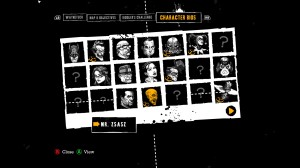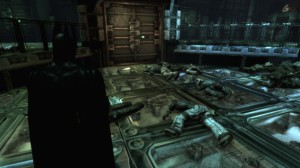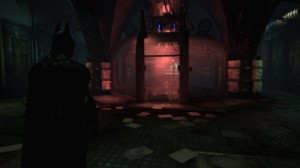Back in part 1 of this piece, I spoke at length about a few things I wasn’t enjoying about my first play-through of Batman: Arkham Asylum. If you read my previous post on the game, you might think I’m not having fun with it, but rest assured that I am. There’s a bunch of things going on in Arkham Asylum that I really dig. In this post, I’m going to highlight and discuss some of those things.
*Minor spoilers about character appearances*
Character Biographies: Concise Texts
Full disclosure: I’m not a huge Batman fan. I’ve read bits and pieces of the comics and can only barely remember watching the cartoons as a kid. Beyond that, I’ve seen the Adam West Batman film abo ut five times and of Christopher Nolan’s film trilogy, I’ve only seen the last two. So I’m kind of familiar with some of the main characters, their motivations, the setting, and some of the fan culture surrounding the IP. Notably, I should make clear, that compared to actual Batman fans, I know very little about the Caped Crusader (that’s Batman, right?). For instance, before playing Arkham Asylum I could only really name four or five Batman villains.
ut five times and of Christopher Nolan’s film trilogy, I’ve only seen the last two. So I’m kind of familiar with some of the main characters, their motivations, the setting, and some of the fan culture surrounding the IP. Notably, I should make clear, that compared to actual Batman fans, I know very little about the Caped Crusader (that’s Batman, right?). For instance, before playing Arkham Asylum I could only really name four or five Batman villains.
So when I started unlocking all these character biographies and dialogue tapes of them speaking, I was really happy. Arkham Asylum has this information system in your pause menu that lets you read quick facts, descriptions, and backgrounds of over 25 Batman characters, including both villains and allies. Furthermore, you can also explore environments off the beaten path to find interview tapes that further flesh out their stories within the game. It’s all really cool to experience.
But the coolest thing about it is that each piece of information is super concise. I hate to compare Arkham Asylum to a completely different type of game, but in the Elder Scrolls games, I could never bring myself to ever seriously read any of the text they throw at you in books or notes. It was all either too long to read or it was presented in a dull way. Arkham Asylum, in this regard, realizes that the player wants to spend most of his/her time playing the core-game rather than reading pages and pages of extra information. And its a shame that other games don’t present their extra information in better ways, because most of the time it can really enrich the overall perception of a game’s world.
it was presented in a dull way. Arkham Asylum, in this regard, realizes that the player wants to spend most of his/her time playing the core-game rather than reading pages and pages of extra information. And its a shame that other games don’t present their extra information in better ways, because most of the time it can really enrich the overall perception of a game’s world.
Arkham Asylum keeps all of these bits of information concise and interesting. The collection of this information is also well-paced and not forced on you, so you can engage in it whenever you want. As a bonus in the entire system, there’s also some awesome character art included in the bios.
Varied Environments: Not Just a Color Swap
One of the most remarkable things about Arkham Asylum is how varied, yet focused, the visual direction behind its environments is. Coming into the game, I thought I’d be spending most of my time in tight, dimly lit, gray corridors. So I was very surprised when I first stepped outside and flew around the Manor, or when I jumped into a blue, electrified prison cell complex, or when I started stealthing (this should be a word) my way through the leafy Arkham Gardens. As a young developer myself, I know first-hand how easy it is to lose focus on particular details is when you cast your scope so wide. Yet in Arkham Asylum, I can’t help but feel that every distinct place I explore is somewhat alive.

This is something I generally enjoy about linear-narrative games over open-world games. Since you have to discretely separate environments in a linear game like Arkham Asylum, you get to have noticeable variety in your levels. In itself, this feature allows players to more quickly take in the effect of different visual styles leaving fresh impressions on the player. You start feeling the need to traverse environments differently not just because level mechanics require you to, but because the different visuals reinforce different behavior.
For example, at around six hours into the game, I found myself in a brand new building of the Asylum. In this building there’s prison cells holding loud and nasty prisoners that no doubt, I’d have to fight eventually. The cells in the main room are wide and central, and most notably, the ground is made up of these bright blue tiles that would light up every once in a while. Eventually I’d find out that these tiles were electrified, and could kill me if I didn’t travel carefully.
Anyways, the vibe set from the first few rooms of this level is quickly altered by the next couple of sets you encounter. Off the main electrified room, there’s a dark and particularly tight path that leads to a misty, red room with a chamber in the center. I was taken aback by how sharply these next couple of rooms contrasted with the past few. Apart from the big chamber (which I’ll get to in a bit), there’s these very tightly packed jail cells, in rows, with maniacs that jump out at you from. Immediately you have to travel the space differently yet again, now being careful as to where these enemies might jump out at you from. It was an awesome change of pace.
being careful as to where these enemies might jump out at you from. It was an awesome change of pace.
Back to that chamber. Inside is Batman villain Poison Ivy, who exchanges some words with the player when you first see her. It’s a brief exchange, but it does a lot to establish Ivy as a (literally) toxic character that you want to keep a distance from. In hindsight it was odd to have had that set-piece there now, but at the time, it was really, really mesmerizing. This jail complex you’ve been in for about fifteen minutes is now dangerous on three separate fronts, each visually manifested in a unique way.
Riddler Trophies: Surprisingly Addictive
Hear me out on this one. When I first thought about the Riddler Trophies in the game, I thought they were just meaningless collectibles meant to make the game feel longer. And you know what, that’s kind of true. But screw it, the most fun I’m having in this game is hunting these damn things.
I’m not entirely sure what the tangible payoff is in finding a majority of them, but I actually feel like I’ve solved a puzzle when I find well-hidden ones. A lot of the time, collecting Riddler Trophies or solving Riddler Challenges doesn’t require much thought, but the ones that do are genuinely satisfying. In hunting for them, I’ve become more comfortable with my surroundings, more attuned with my exploratory abilities, and I actuall y feel like I’m upsetting the Riddler when I best him.
y feel like I’m upsetting the Riddler when I best him.
It’s weird, right? In a sense, this system isn’t much different from a lot of other monotonous game-lengthening collect-athons (I’m lookin’ at you, GTA). Yet I really enjoy finding Riddler Trophies, despite it being (nearly) mechanically similar to finding Nirnroot in Oblivion or Hidden Packages in GTA3. Once again I’m comparing different kinds of games, but there’s some reasonable structure and direction involved with finding Riddler Trophies. In order to find them, your ability to play the game is at least somewhat tested; you don’t just have to stare at the ground for extended periods of walking. Most importantly however, I think that the key feature is that they’re tied to a rich character with engaging dialogue to keep you interested. It’s a competition between me and the Riddler. And damn it, Riddler won’t outsmart me.
So there you have it…
Of course there’s a whole other bunch of stuff I’m enjoying about the game besides these three things, but getting into all of them would take a lot more effort to organize and write out. But these three things are done so freaking well. I’m having an awesome time playing through Arkham Asylum despite the faults I discussed last time.
I should also make a note of some of those faults from last time. Having played more of the game since, some of those things are still terrible, like predictable level designs and some repetitive sequences. However, boss fights and combat have gotten a little bit better, especially stealth sequences. It’s very possible that Arkham Asylum is at its best when you haven’t been seen by your enemies yet and you’re trying to decide in which way to take them out. Why didn’t I write about that here? Well I don’t know, maybe I’m planning a piece on cool stealth mechanics in games. Check in soon to find out!

